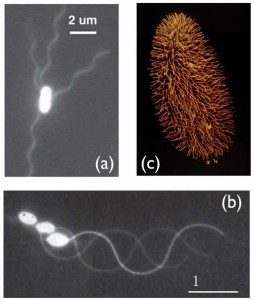
Various low Reynolds number swimmers. (a) E coili bacterium. (b) Swimming spermatozoon of Ciona intestinalis. (c) Paramecium cell.
This month’s fluid dynamics symposium, run by the Max-Planck Institute for Dynamics and Self-Organisation was on the topic of locomotion in fluids. Talks were given by Anders Andersen from the Technical University of Denmark, on Copepod dynamics, Albert Bae from UC San Diego, on swimming amoebae and Eric Stellamanns from the Max-Planck Institute for Dynamics and Self-Organisation, on Trypanosome motility.
Copepod hydrodynamics
Copepods are a group of small crustaceans and zooplankton found in both salt and fresh water environments. In terms of other plankton Copepods are fairly large, ranging in size from a few hundred microns to a few millimetres. In order to catch prey and escape from predators, the Copepods have small sensory hairs along their antenna and tails. These hairs or setae, detect small disturbances in the surrounding environment. If the disturbance is small (only picked up by few hairs) then the Copepod knows prey is nearby and can attack. If the disturbance is large (picked up by many hairs) then the Copepod knows to get ready to flee a potential predator.
In order to capture prey, the Copepods use ambush feeding. Most of the time the Copepod is motionless in the water waiting for prey to swim by. When one does, the Copepod springs into motion capturing the prey. The whole process of detection to capture takes only a few milliseconds, with the Copepod attacking at speeds of ~100 mm/s. On Anderson’s website a series of images can be found showing the attack process.
Apart from the speed and motion during attack, the main point of interest is that the prey remains stationary during the whole process, despite the Copepod moving substantially. This is of course necessary for a successful ambush; if the prey notices the Copepod moving it will potentially be able to escape. Simulations show that only a very thin viscous boundary layer develops around the attacking Copepod due to its high Reynolds number ~100, minimising the flow around the prey and preventing detection. The results were published in PNAS.
Also discussed in the talk were the kinematics of escape jumps in the Copepods. Copepods of all sizes use a cycle of power strokes and passive coasting to move from one place to another. Each cycle lasts 10-20 ms with the ratio of the stroke time to coasting time varying with the size of the Copepod. This mechanism results in a highly fluctuating escape velocity, with speeds of 120-450 mm/s being reached. The results can be found in the Journal of the Royal Society Interface, where a simple swimming model in used to accurately capture the kinematics of the motion.
Related papers in Soft Matter
Two recent interesting papers, published in Soft Matter, on the locomotion in fluids include: Life around the scallop theorem, Eric Lauga. This paper reviews methods of locomotion for swimmers at low Reynolds numbers. Hydrodynamic synchronisation at low Reynolds number, Ramin Golestanian et al. This paper reviews recent experimental and theoretical work on hydrodynamic synchronisation, such as that seen between bacterial flagella.










